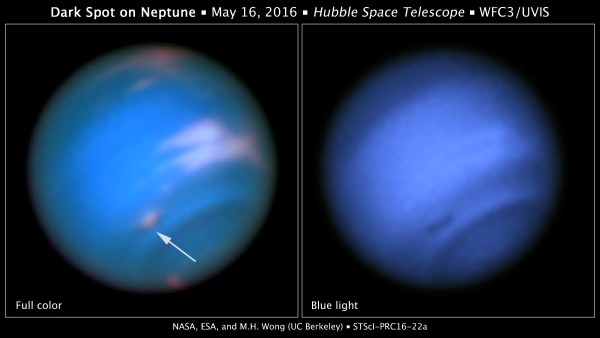A mysterious dark spot has been detected on Neptune as astronomers used the Hubble Space Telescope to study this unprecedented feature on the gas planet.
This spot is apparently a dark vortex generated by a high pressure system in Neptune's thick layer of gases enshrouding the planet, as atmospheric elements are being driven upward.This atmospheric activity are now forming flat clouds that were first spotted by amateur astronomers in July 2015. Astronomers quickly responded to these new findings, as they discovered a dark formation was generating these flat, round clouds.
According to Mike Wong from the University of California, Berkeley, these dark vortexes can span through Neptune's atmosphere that can be described as gaseous mountains that are shaped like a lens. Its companion clouds are also similar to orographic clouds that appear to possess features similar to a pancake, that lingers around the mountains on Earth.
This theory has now been confirmed by these new observations which also marks the first time that these pancake shaped clouds have been detected in Neptune.
Astronomers also reveal that during a flyby of NASA's Voyager 2 spacecraft of Neptune in 1989, astronomers were surprised to spot a gigantic, dark hole located in the southern hemisphere of the cyan atmosphere of the gas planet. After some years, this dark spot mysteriously disappeared however, Hubble detected a new dark spot in the northern hemisphere in 1994 that is also similar in size.
This newest image of Neptune's dark vortex was captured last May 16, where this region is estimated to be the size of the Untied States based on the continent's width. The Hubble Space Telescope is also the only observatory that can detect these spinning dark vortexes on a distant planet in our solar system.
Similar phenomena can also be seen on other planets in the solar system. On Jupiter, its bright red spot lasted for several decades or even centuries as they also evolve through time. On Neptune however, these atmospheric systems appear to be more short lived and present more variations in their life spans, shapes and sizes as well. Apart from this, Neptune is also host to the fastest wind speeds recorded anywhere in the solar system at almost 1,340 miles per hour almost reaching supersonic flows.
This newly found vortex could also offer new insights about how such systems form and what conditions are required to generate them, and why they dissipate over time. This crucial data can also reveal the atmospheric conditions of Neptune and its inner workings. On Neptune, it can take 165 years to complete a single orbit around our sun.


